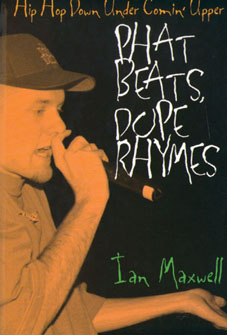The beats go on
Seb Chan on Ian Maxwell's Phat Beats, Dope Rhymes
 Ian Maxwell, Phat Beats, Dope Rhymes: Hip Hop Down Under Comin’ Upper, Wesleyan University Press, Conneticut, 2003 ISBN 0 8195 6638 1
Ian Maxwell, Phat Beats, Dope Rhymes: Hip Hop Down Under Comin’ Upper, Wesleyan University Press, Conneticut, 2003 ISBN 0 8195 6638 1
The publication of Ian Maxwell’s Phat Beats, Dope Rhymes coincides with a boom in Sydney hip hop. Local bands are making a serious impact on national touring circuits previously dominated by rock and the record sales of some independent labels are breaking into 5 figures. Even major labels are getting in on the action with Warners commissioning a compilation of strictly independent local hip hop entitled Straight From The Art. Event promoters and touring companies are falling over themselves to tour hip hop artists and the dance scene is once again crossing over into hip hop territory through multi-stage events. Local hip hop periodical Stealth Magazine continues to grow and is now available in regular newsagents nationwide, as well as being exported overseas. Triple J has a dedicated hip hop show for the first time since Tim Ritchie introduced many to the sounds of electro and early hip hop in the mid-80s, while support from community stations like 2SER and FBI remains strong. There is now a hip hop film festival (RT 59, p44), a plethora of online forums and websites, and various conferences for producers, writers and MCs. It wasn’t always this way.
Maxwell’s book covers the formative period of Sydney hip hop from 1992 to 1994, a few years after the notorious moral panic surrounding the ‘Reebok bandits’ hanging around Hoyts on Sydney’s George Street. The book focuses on 3 main characters. The first is Miguel D’Souza, whose Mothership Connection radio show on 2SER was one of the seminal hip hop listening experiences for much of the 90s. Miguel was more a facilitator than presenter, with the bulk of his program dedicated to live-to-air freestyle sessions and guest DJs. The book’s second character is Blaze, editor of Vapours, a bedroom-produced fanzine and the most important document of early Sydney hip hop. Blaze was also an important part of The Lounge Room, the first incarnation of what is now Next Level, the prime independent Sydney record store for local and international independent hip hop. Blaze is also a DJ, radio presenter and record producer and remains a key figure today. The book’s final character is Ser Reck, MC and key player in Def Wish Cast and more recently Celsius. Def Wish Cast are best known for their debut Knights Of The Underground Table, which sold well locally and in Europe, making it possibly the first Australian hip hop record to earn such international respect.
Phat Beats is largely ethnographic in approach. There is an engaging dissection of particular freestyles on Miguel’s radio show and at The Lounge Room and a discussion of how the local hip hop scene has been created through the production of myth and identity. The book also dissects elements of Blaze’s writing style in Vapours and the production of Knights Of The Underground Table, which is evaluated against Sound Unlimited Posse (anyone remember them?). Maxwell reads these subcultural texts/events like an insider (although he is at pains to point out that he doesn’t consider himself a participant observer) and it is clear he has earned the trust of those involved in the scene. He excels at unpicking the internal politics and underlying tensions of style, subcultural capital and place in those early years. He also turns a spotlight on the serious academic thought within the scene through Blaze’s writing for Vapours and Miguel’s radio show and column in 3D World.
Interestingly, many of the same tensions and myths described in the book continue to play out in the Sydney hip hop scene today. Shortly after the period the book covers, one of the featured freestyle protagonists, JU (who also appears on the cover), became a member of Easybass. This group were part of a mid-90s crossover between the hip hop and the inner city/Eastern Suburbs house and rare groove scenes. Along with Metabass ‘n’ Breath, whose roots lay in performance art, theatrics and poetry, Easybass brought hip hop to a largely middle class inner city audience. So while hip hop boomed in the inner city, ‘real’ crews struggled to find an audience in the ‘authentic’ western suburbs, largely due to a lack of venues and the cultural impact of low density suburban planning. As every crew that made the leap from cipher to stage quickly discovered, subcultural authenticity doesn’t guarantee a good crowd. The same scene politics were played out a few years ago with the rise of ‘felafel rappers’, a disparaging term used to describe “leftie inner city vegan rappers.”
Where Phat Beats falls a little short is in its sometimes uneven incorporation of theory into the flow of the text. It is here that the book’s roots as a doctoral thesis and the concessions made to an intended overseas academic audience are most apparent. This is a minor annoyance however. Phat Beats digs deep inside subcultural politics, media and expression and gives proper definition to the formation of a distinctive local scene. Given the focus on subcultural music, it would have been nice if the book had also come with a CD.
RealTime issue #60 April-May 2004 pg. 8






